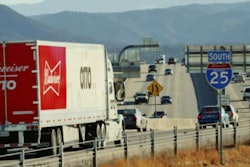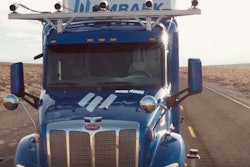Bryan Spoon posed what may have been the most interesting question asked during a listening session about autonomous trucks convened by the Federal Motor Carrier Safety Administration Monday, April 24 in Atlanta.
(See a video of the complete session below.)
As the session at the annual Commercial Vehicle Safety Alliance workshop wound down, the owner/operator from North Carolina posed a hypothetical question:
If an autonomous truck with no driver at the wheel is in a situation where it must choose between hitting a brick wall and destroying itself or avoiding it and driving towards a group of children getting off a school bus, what does the truck do?
 The panel at Monday’s FMCSA listening session on autonomous trucks
The panel at Monday’s FMCSA listening session on autonomous trucksThat was one of the thornier — and more philosophical — questions asked at the session meant to allow interested parties to share comments and raise questions about autonomous trucks with the FMCSA.
Kicking off the meeting FMCSA Deputy Administrator Daphne Jefferson said, “Our goal is not to impede progress but for us as regulators to try to run alongside development as it moves forward so we are understanding what is going on and continue to be the voice of safety in the room.”
Among the concerns heard by the panel were:
- Whether the driver of an autonomous truck must stay in the seat even when the truck is “driving” itself or if they can be in the sleeper berth
- If such trucks will need to be identified in some way so law enforcement and other motorists will know they are autonomous
- What security safeguards are needed to keep these trucks from being hacked
- Whether an autonomous truck will “know” it must enter a weigh station to be inspected
- What a police officer will have to do if they need to stop a truck the driver of which may be in the sleeper berth and not at the wheel
- How responsibility will be determined in case of an accident
- The need for technicians to work on autonomous trucks
- Any new criteria for roadside inspections to address autonomous driving systems
- Implications for hours of service regulations
- Should autonomous trucks be exempt from hauling hazardous materials
Tom Balzer, president of the Ohio Trucking Association suggested truck drivers might not be replaced as soon as some people think they might.
“There is a gigantic void between what is reality and what is the Hollywood version of what is going on. We are a long, long way from a truly driverless truck.” said Balzer. He added that the 120-mile delivery of Budweiser beer made in Colorado last October by an autonomous truck equipped with technology from Otto was “an excellent marketing ploy.”
Sean Garney, representing the American Trucking Associations, told the panel autonomous technology has the “potential to improve all aspects of trucking,” but that oversight of it needs to be solely the responsibility of the federal government and not be performed at the state and local levels. If necessary, said Garney, the federal government ought to exercise its power of preemption to maintain such control.
But, he also told the panel that the government should not stifle development of the technology.
MCO Transport Safety Director Danny Hefner said he watched the recent demonstration delivery by an driverless autonomous truck developed by Uber-owned Otto and “as a citizen it really put me off.” Hefner then posed the question of what would happen if a steer tire on such a truck blew out with no driver at the wheel. Would, he asked, the truck be able to stay in its lane and avoid a life-threatening collision?
If you have comments to share with FMCSA about autonomous trucks, you have until July 17 to deliver them to the agency. Make your comments here.












